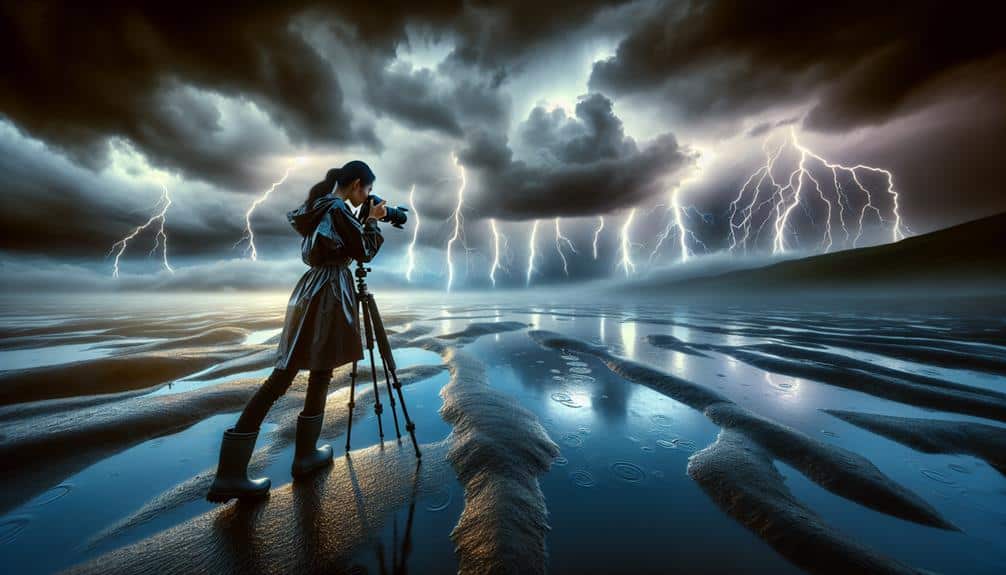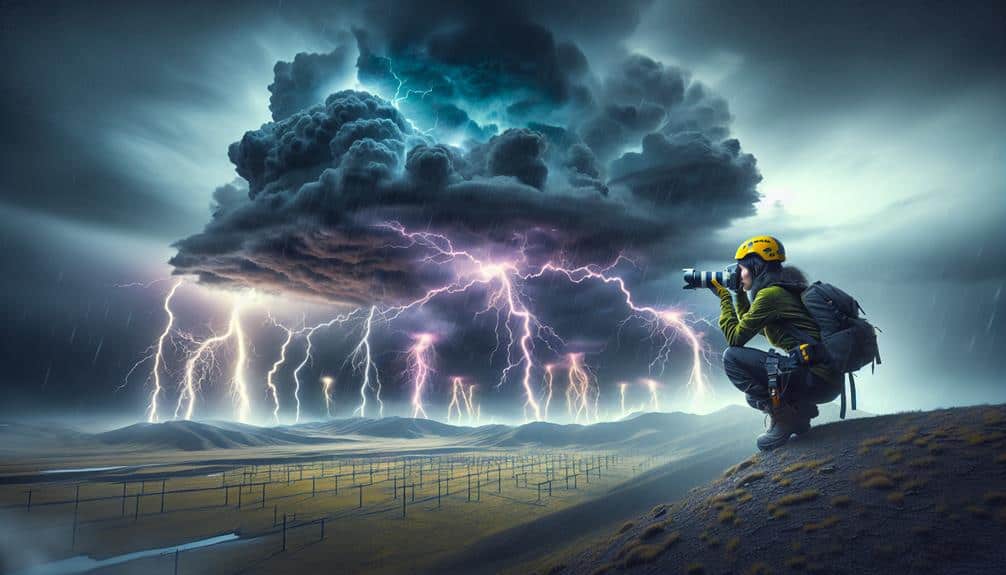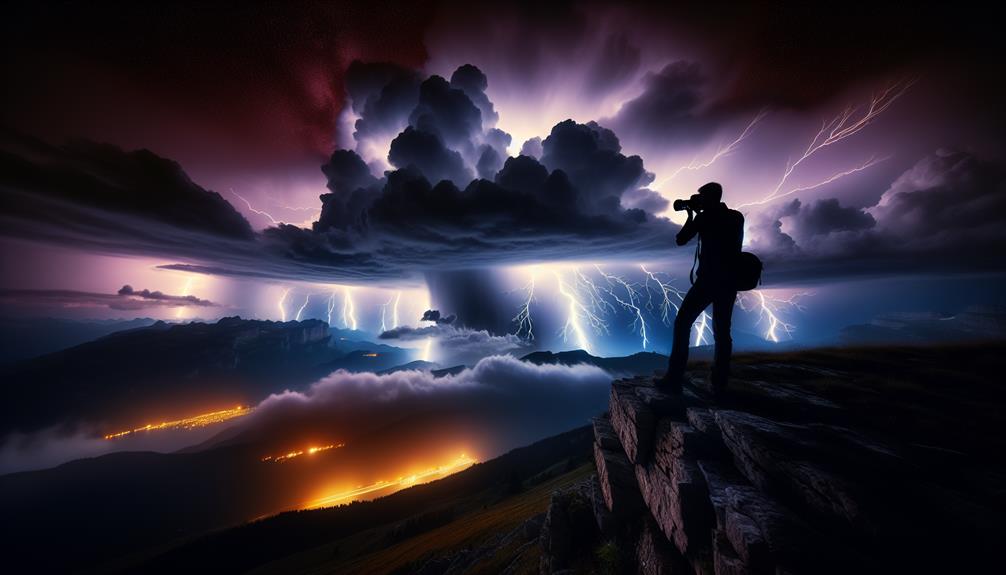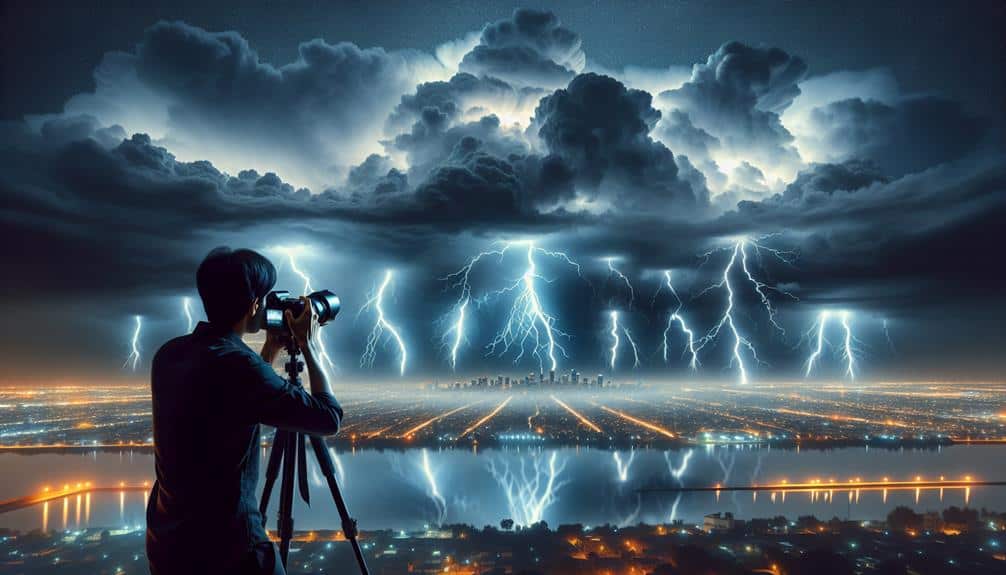To capture lightning strikes like a pro, we recommend high-resolution cameras with precise ISO, aperture, and shutter speed control, especially using 'Bulb' mode. Pair them with durable carbon fiber tripods and responsive lightning triggers that offer adjustable sensitivity and smartphone connectivity. Wide-angle lenses between 14mm and 24mm with large apertures like f/2.8 are essential for expansive, clear night scenes. Don't forget weatherproof clothing and insulated gear for safety. Utilize advanced weather apps and high-resolution radars for real-time storm tracking and lightning alerts to position yourself perfectly. Dive deeper to master these tools and techniques.
Key Points
- High-resolution cameras with adjustable ISO, aperture, and shutter speeds capture intricate lightning details.
- Carbon fiber tripods with ball heads provide stability and quick camera adjustments.
- Lightning triggers detect strikes faster than human reflexes for precise capture.
- Wide-angle lenses (14mm-24mm) with large apertures like f/2.8 are ideal for expansive, clear night shots.
High-Resolution Cameras
Harnessing the capabilities of high-definition cameras, we can capture the intricate particulars and swift occurrences of lightning strikes with unmatched clarity. Our journey commences with selecting cameras that showcase exceptional sensor sensitivity and dynamic range, enabling us to record the transient brilliance of lightning against the night sky.
When it comes to camera settings, we need to meticulously fine-tune the ISO, aperture, and shutter speed. For night photography, an ISO setting around 400 to 800 strikes a balance between noise and sensitivity. A moderate aperture, such as f/5.6, provides depth of field without compromising light intake. The key lies in the exposure; setting the shutter speed to 'Bulb' mode allows us to manually regulate the exposure duration, capturing the precise moment of the strike.
Following the capture, our editing phase is where high-definition stands out. We can enhance details without sacrificing quality, utilizing software like Adobe Lightroom. Adjusting contrast and highlights can emphasize the lightning's sharpness, while noise reduction tools guarantee the night sky remains untouched.
Tripods and Mounts
To ensure our high-resolution cameras capture the fleeting brilliance of lightning strikes with stability, we must employ sturdy tripods and flexible mounts. The stability essentials here can't be overstated, as even the slightest movement can blur the sharpness of a lightning bolt. We need tripods that offer a rock-solid foundation, especially in windy conditions.
Let's explore the key components of our setup:
- Heavy-Duty Tripods: Opt for carbon fiber tripods that combine durability and lightness. They offer excellent stability fundamentals.
- Ball Heads: These allow us to adjust our cameras quickly for creative angles, ensuring we capture the most dynamic lightning effects.
- Quick Release Plates: These make it easy to mount and dismount our cameras, which is vital for repositioning techniques during a storm.
Lightning Triggers
Capturing the exact moment a lightning bolt strikes requires the use of advanced lightning triggers that detect and respond to electrical discharges faster than human reflexes. These specialized devices are essential for lightning photography, offering trigger options that range from basic to highly sophisticated.
We need to understand the importance of pairing our lightning triggers with best camera settings. Typically, we set our cameras to manual mode, utilizing a lower ISO (around 100-200) to minimize noise and a narrower aperture (f/8-f/16) to achieve greater depth of field. The lightning trigger connects to the camera's remote port, setting off the shutter the instant it senses an electrical discharge.
For those of us aiming to create truly stunning and creative compositions, experimenting with different trigger options can yield unique results. Some triggers offer adjustable sensitivity, allowing us to capture distant or faint lightning strikes, while others include built-in intervalometers for time-lapse sequences.
Advanced lightning triggers, such as the Nero Trigger or the MIOPS Smart, even offer smartphone connectivity, granting us the freedom to control our setups remotely. This allows us to stay safe and dry while our cameras bravely face the storm, capturing nature's electrifying show with accuracy and artistry.
Wide-Angle Lenses
Pairing our lightning triggers with high-quality wide-angle lenses enhances our ability to capture expansive sky scenes, framing the full majesty of lightning storms. Wide-angle lenses, typically ranging from 14mm to 24mm, allow us to encompass vast portions of the sky, ensuring we don't miss any spectacular bolts. For night photography techniques, these lenses excel due to their ability to gather more light, reducing the need for longer exposure times that might otherwise blur the strikes.
When selecting a wide-angle lens, we should consider:
- Aperture Size: A larger maximum aperture (like f/2.8) is ideal for night photography, enabling us to capture brighter, clearer images.
- Lens Distortion: Look for lenses with minimal distortion to maintain the natural integrity of the storm's dramatic lines and shapes.
- Build Quality: Weather-sealed lenses offer protection against the elements, essential during storm shoots.
Incorporating creative composition strategies, such as positioning foreground elements or using the rule of thirds, further elevates our lightning photography. By combining advanced equipment and refined techniques, we capture the raw, untamed beauty of lightning in a way that speaks to our desire for freedom and adventure.
Protective Gear

When capturing lightning strikes, we must prioritize our safety by equipping ourselves with weatherproof clothing, such as Gore-Tex jackets and insulated gloves.
Let's prioritize we follow an all-encompassing safety precautions checklist that includes grounding techniques and maintaining a safe distance from conductive structures.
Proper protective gear not only safeguards us but also enables us to focus on capturing that perfect shot.
Weatherproof Clothing Essentials
To guarantee safety and comfort while capturing lightning strikes, we must invest in high-quality, weatherproof clothing that includes insulated gloves, moisture-wicking base layers, and robust outer shells designed to withstand harsh conditions. Our choice of gear guarantees we remain focused on our lightning photography, rather than battling the elements.
First, let's talk about waterproof accessories. These are indispensable in our arsenal. A durable, waterproof jacket with sealed seams will keep us dry during sudden downpours. Paired with waterproof pants, we're fully shielded from rain and wind. Our hands, essential for operating cameras and adjusting settings, need insulated, waterproof gloves that offer both warmth and dexterity.
Essential items include:
- Waterproof jacket and pants: Keeps us dry and protected from wind.
- Insulated gloves: Ensures warmth and precise control over camera settings.
- Moisture-wicking base layers: Regulates body temperature and keeps us comfortable.
Safety Precautions Checklist
Equipping ourselves with reliable protective gear is essential for safeguarding our safety while photographing lightning strikes. Safety precautions are non-negotiable when diving into lightning storm photography.
First and foremost, let's discuss the essentials: a sturdy, insulated pair of rubber-soled boots. These boots provide an important barrier against ground currents.
Next, a high-quality, non-conductive tripod is crucial. Metal tripods can act as lightning rods, so investing in a carbon fiber version significantly reduces risk.
Additionally, wearing a weather-resistant, dielectric jacket and pants is necessary. This advanced safety gear can protect us from electrical discharges while ensuring we remain dry and comfortable.
For added protection, we should consider a portable lightning detector. These devices alert us to nearby strikes, granting us important moments to seek shelter.
A strong, insulating mat to stand on can further mitigate the risk of ground conduction. It's also wise to have a remote shutter release to maintain a safe distance from the camera during captures.
Adopting these lightning photography techniques and adhering to these safety gear recommendations not only enhances our creative freedom but also ensures that we remain safe and sound while capturing nature's electrifying spectacle.
Weather Apps and Radars
Let's leverage advanced weather apps and radars for effective lightning capture. By utilizing real-time storm tracking, we can pinpoint lightning activity with precision. Lightning strike alerts keep us informed of imminent strikes.
Predictive weather models allow us to anticipate storm patterns, ensuring we're always prepared for the perfect shot.
Real-Time Storm Tracking
Utilizing advanced weather apps and high-resolution radars, we can achieve precise real-time storm tracking to effectively capture lightning strikes. By integrating this technology into our lightning photography techniques, we elevate our storm chasing adventures to new heights.
High-resolution radars provide us with detailed storm data, allowing us to pinpoint the most active lightning zones. When paired with sophisticated weather apps, we gain a powerful toolkit for real-time analysis and decision-making.
With these tools, we can:
- Monitor thunderstorm development: Real-time updates on storm intensity and trajectory help us plan our shots with precision.
- Analyze lightning frequency: Detailed data on lightning strikes per minute guides us to the most electrifying locations.
- Track storm movement: High-resolution radar allows us to follow storms across vast areas, ensuring we stay in the right place at the right time.
Harnessing these technologies, we can embrace the freedom of capturing nature's most powerful displays while staying informed and safe. Real-time storm tracking is the cornerstone of successful lightning photography, blending expertise and adventure seamlessly.
Lightning Strike Alerts
Cutting-edge weather apps and high-resolution radars provide critical lightning strike alerts, allowing us to anticipate and capture electrifying moments with pinpoint accuracy. Leveraging advanced lightning detection technology, these tools offer real-time data that's essential for refining our lightning photography techniques.
We can monitor storm cells, track lightning activity, and receive precise strike alerts that inform us when and where to set up our gear.
For storm chasing opportunities, apps like My Lightning Tracker and RadarScope are indispensable. My Lightning Tracker delivers real-time notifications of lightning strikes within a customizable radius, offering us a tactical advantage. RadarScope, on the other hand, provides high-resolution radar data, enabling us to visualize storm structures and identify potential lightning hotspots.
In our quest for freedom and the perfect shot, these technologies empower us to make informed decisions. By integrating these tools into our workflow, we can optimize our positioning and timing, ensuring we capture the full drama of nature's light show.
Whether we're veterans or novices in the field, mastering these resources will undeniably elevate our craft, making each storm chase not just an adventure, but a calculated strike of photographic genius.
Predictive Weather Models
In an era where accuracy is paramount, predictive weather models harness the power of sophisticated algorithms and vast datasets to provide us with hyper-local forecasts and real-time storm tracking capabilities. These models analyze intricate weather patterns to enhance forecast accuracy, ensuring we're always a step ahead when capturing that perfect lightning strike.
Utilizing the latest weather apps and radars, we can anticipate storm movements and lightning activity down to the minute. This predictive edge is important for mastering advanced lightning photography techniques while maintaining lightning safety.
Let's explore some essential tools:
- RadarScope: A high-resolution radar app that provides real-time storm data, helping us pinpoint the exact location and movement of lightning-producing thunderstorms.
- Storm Radar: Offers an interactive map with advanced storm tracking features, allowing us to visualize weather patterns and forecast upcoming lightning events.
- My Lightning Tracker: Delivers real-time lightning strike notifications and detailed storm information, optimizing our timing and positioning for lightning photography.
Frequently Asked Questions
How Do I Ensure My Safety While Photographing Lightning?
Just like storm chasers, we prioritize safety precautions, using proper gear to mitigate dangers involved in lightning photography. We stay inside vehicles or buildings, use tripods with remote triggers, and avoid high ground and open fields.
What Settings Should I Use to Capture Lightning at Night?
For night photography, we should use long exposure settings around 10-30 seconds, set our aperture to f/8-f/11, and keep the ISO low (100-400). Using a sturdy tripod and remote shutter release guarantees sharp captures.
Can I Use a Smartphone to Photograph Lightning?
Can we capture lightning with a smartphone? Absolutely, but there are smartphone limitations. While possible, professional equipment offers superior control and results. For freedom in photography, advanced gear provides precision that smartphones can't match.
How Can I Predict the Best Time for Lightning Photography?
To predict the best time for lightning photography, we use weather apps to track storm activity. Time lapse captures stunning sunsets and dramatic cloud formations, enhancing our opportunities. Advanced techniques and equipment guarantee we seize the moment.
What Post-Processing Tips Enhance Lightning Photos?
Some might think post-processing isn't necessary, but it's vital for refining our lightning photography techniques. Use high dynamic range (HDR) to enhance lightning images, and adjust contrast, exposure, and saturation for stunning results.


